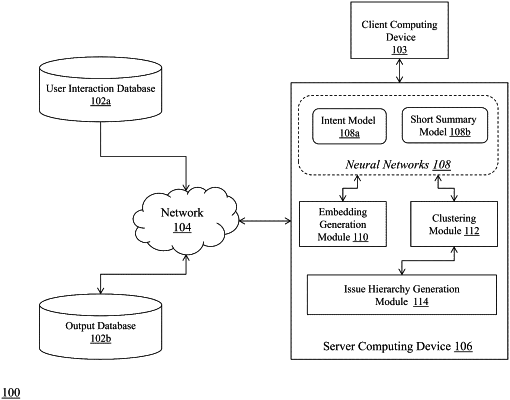| CPC G06Q 30/016 (2013.01) [G06F 18/21355 (2023.01); G06F 18/22 (2023.01); G06F 40/284 (2020.01); G06N 3/044 (2023.01); G06N 3/08 (2013.01)] | 18 Claims |

|
1. A computerized method of automated analysis of customer interaction text to generate customer intent information and a hierarchy of customer issues, the method comprising:
capturing, by a server computing device, a plurality of computer text segments, each segment including (i) a first portion comprising a transcript of an interaction between a customer and an agent and (ii) a second portion comprising notes about the interaction between the customer and the agent, as generated by the agent;
generating, by the server computing device, first embeddings for a trained intent classification model by selecting computer text segments that have a quantity of tokens in the second portion that is at or below a threshold quantity and converting each selected computer text segment into a multidimensional vector representing the computer text segment using a first one-hot encoder;
generating, by the server computing device, second embeddings for a trained short summary generation model by selecting computer text segments that have a quantity of tokens in the second portion that is above the threshold quantity and converting each selected computer text segment into a multidimensional vector representing the computer text segment using a second one-hot encoder;
executing, by the server computing device, the trained intent classification model using the first embeddings as input to generate a predicted customer intent for each computer text segment;
executing, by the server computing device, the trained short summary generation model using the second embeddings as input to generate a predicted short summary for each computer text segment;
combining, by the server computing device, the predicted customer intent and the predicted short summary for each computer text segment into an interaction summary for the computer text segment;
converting, by the server computing device, each interaction summary into a multidimensional vector representing the interaction summary using a trained language model;
assigning, by the server computing device, one or more entity tags to each interaction summary using a trained named entity recognition model;
grouping, by the server computing device, the interaction summaries based upon the assigned entity tags;
aggregating, by the server computing device, the multidimensional vectors representing the interaction summaries into one or more clusters based upon a similarity measure between the respective multidimensional vectors; and
aligning, by the server computing device, the one or more clusters of vectors with the groups of the interaction summaries to generate a hierarchical mapping of customer issues.
|